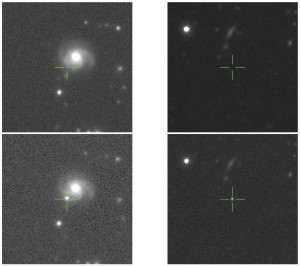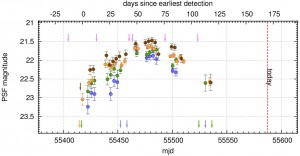Powerful and distant explosions could be boosted by the universe’s strongest magnets
June 7th, 2013 by Cosimo Inserra Tags: magnetar, Pan-STARRS1, supernovaCore-collapse supernovae are explosions of the most massive stars in the universe and are responsible for producing every element in the periodic table heavier than iron. However it seems that some of the more unusual supernovae may have been boosted by the most powerful magnets in the universe.
In recent years, the discovery of a number of unusually luminous stellar explosions in small, distant galaxies is challenging our previous ideas about these events. It is no exaggeration to say that the field has been revolutionized by the new generation of surveys, such as Pan-STARRS1. The early discoveries of these explosions suggest that these super-luminous (100x more luminous than a typical exploding star)
supernovae are quite diverse. They are remarkable bright, one hundred times brighter than the explosion of a massive star (at least 7-8 times our Sun). They explode in small and faint galaxies with an abundance of metal elements lesser than what we observe in the Milky Way, and until now none of these super luminous objects have been found closer than 1.5 billion light years.
Although these Supernovae are explosions in galaxies far, far away, the astronomers are confident that they are not consequences of a planet being destroyed by a laser being fired from a small moon (“That’s no moon, it’s a space-station”). Indeed, some scientifically valid ideas have been proposed. To explain the high luminosity of such events. The likely suspects are: 1) having an extra source of energy boosting the total explosion energy; or 2) converting all the energy into light (generally only 10% of energy is transformed into light). Thanks to Pan-STARRS1 we had the opportunity to study five of these rare supernovae at distances close enough to allow us to have the best sample of data so far. Supernovae brighten over several days as the explosion lights up the gas around the dying star. Following this they gradually fade with time. We were able to collect data until roughly 300 days after the peak luminosity (a phase called “tail” of the luminosity pattern) and monitor the fading of the light coming from the explosion. Revealing for the first time an unexpected flattening of the luminosity at this stage. This new evidence lead us to look for an extra source of energy boosting the supernova’s output during this phase.
We looked for physical and feasible possibilities and we found that a magnetar could be a really good candidate for the additional power source. What is a magnetar? When a star explodes, it can leave behind a rotating and magnetic stellar remnant, called neutron star (abbreviated NS). If the NS spins rapidly and its magnetic field is exceptionally strong magnetic field it is called a magnetar. This can have a magnetic field one hundred thousand billion times stronger than that of the Earth and ten billion times stronger than a typical fridge magnet!. This magnetar then rapidly spins down, deposits its rotational energy into a supernova explosion and thus significantly enhances the luminosity. Thanks to a semi-analytical model, we plugged in magnetar in a normal SN event being able to reproduce the entire luminosity behaviour until the late phase, thus we could say that we caught a magnetar by the tail!
We reached a remarkable result, but this is only a starting point because, as scientists, we have to explore all possible scenarios and repeat the experiment (in our case this means using the model on as many SNe as possible) to make it trustworthy. Our journey to the mysteries of these luminous explosions has just begun!



